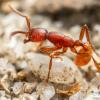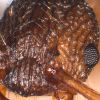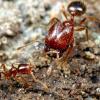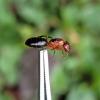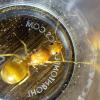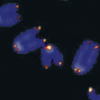I followed the key you sent and it brought me to Leptothorax. I probably messed up somehow but this is what I went though.
1. Antenna with 11 segments, apical club variable => 2
2. Postpetiole attached to anterior face of following abdominal segment 4 (AA) and not capable of flexing upwards over dorsal surface of body. Petiole nearly always with distinct dorsal node (BB). If node absent (Xenomyrmex), petiole not strongly flattened => 3
3. With head in side view, lacking diagonal carina running from the mandible insertions to above the eye (AA), though longitudinal rugae may be present on sides and front of head. Antenna often with a 2- or 3-segmented club (BB). Head and body usually lacking tubercles, but spines or teeth may be present (CC) => 8
4. Frontal carinae not greatly expanded to cover the sides of the head in full-face view (AA). Antennal scrobes, when present, shallow and not receiving entire scape (AA). Promesonotum not laterally marginate or spinose (BB). Monomorphic, except for one rare, minute species => 9
5. Petiolar node nearly always present and well developed (AA); if absent, then propodeum with spines or teeth (BB) => 10
6. Antennal club 3-segmented (AA), absent, or indistinct => 12
7. Frontal carinae ending far short of occipital margin, seldom surpassing the eye (AA) => 15
8. Eye present, often with 10 or more facets. Mandible subtriangular, with more than four teeth. Propodeum usually with teeth or spines (AA), sometimes just angulate at juncture of dorsal and posterior faces => 16
9. Eyes lacking erect hairs => 17
10. Dorsal surface of petiole node unarmed, without a pair of short spines or tubercles => 18
11. Mandible with six teeth (A). Usually, median portion of clypeus smooth and longitudinally excavate, lacking carinae centrally; several carinae usually present on lateral portions => Leptothorax
All these are just copy pasted from the key sent but you can see the path I followed.
Edited by DDD101DDD, December 11 2020 - 11:02 AM.

